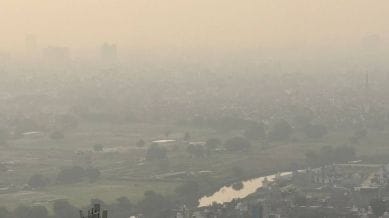Stay updated with the latest - Click here to follow us on Instagram
Delhi-NCR AQI (19 October 2025): Delhi air quality slips into ‘severe’ category ahead of Diwali; NCR pollution levels rise further
Delhi-NCR AQI Level Today, 14 October 2025: Check the latest air quality index, pollution level, and smog conditions across Delhi and NCR with health safety advice and AQI category updates.

Delhi Air Quality Index (AQI) Level Today, 19 October 2025: As we inch towards colder days, the air quality across Delhi-NCR is already deteriorating, with pollution levels moving toward the “very poor” category. As Diwali approaches, the festive week could see a further spike as firecrackers add to the existing mix of stubble smoke, dust, and vehicular emissions, making the capital’s air heavier in the days after the festival.
According to private air quality monitor and forecaster AQI.in, the air quality in the national capital currently falls under the “severe” category, recording an AQI of 257, as per 7 am. The Air Quality Early Warning System (EWS) for Delhi, however, pegged the AQI slightly higher at 274.
monthly limit of free stories.
with an Express account.
On Saturday (October 18), a day before Chhoti Diwali, several localities in Delhi recorded air quality in the “very poor” category, with the overall AQI at 255.
Localities such as Ashok Vihar reported the highest pollution levels on Sunday, with readings ranging from 326 to 412, placing them in the “hazardous” category.
| Area | AQI |
|---|---|
| Anand Vihar | 418 |
| Wazirpur | 324 |
| Bawana | 284 |
| Model Town | 277 |
| Dwarka | 248 |
| Jahangirpuri | 246 |
| Shahdara | 320 |
| Saket | 247 |
| Mundka | 202 |
| Narela | 205 |
| Rohini Sector 24 | 350 |
| Alipur | 223 |
| Yojna Vihar | 354 |
According to AQI.in, breathing in Delhi is currently as harmful as smoking 6.1 cigarettes a day. This estimate is based on the average PM2.5 concentration over the past 24 hours, assuming continuous exposure during that time.
Weather forecast for New Delhi
The temperature in the national capital on Sunday morning was 21.2 degree Celsius, with humidity at 95 per cent.
NCR AQI update
Air quality across the National Capital Region is also worsening. The AQI in Ghaziabad stood at 299 at 7 am, while Noida and Greater Noida recorded 298 and 268, respectively — all falling under the “severe” category.
The PM2.5 concentration on Sunday was measured at 174 µg/m³, far exceeding the World Health Organization (WHO) limit of 15 µg/m³. The current PM2.5 level in New Delhi is 11.6x above the recommended guideline. According to the WHO, “exposure to PM2.5 can cause diseases affecting both the cardiovascular and respiratory systems, including stroke, lung cancer, and chronic obstructive pulmonary disease (COPD)”.
The AQI scale categorises air quality as follows: Good (0–50), Satisfactory (51–100), Moderately Polluted (101–200), Poor (201–300), Very Poor (301–400), and Severe (401–500) — the higher the reading, the more harmful it becomes to breathe.
Health advisory
With the AQI consistently rising, Delhi-NCR residents are advised to wear masks and stay indoors as much as possible to avoid breathing in toxic air. Health experts also recommend avoiding outdoor activities such as walking, jogging, or exercising due to high pollutant levels.